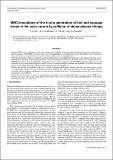Files in this item
MHD simulations of the in-situ generation of kink and sausage waves in the solar corona by collision of dense plasma clumps
Item metadata
| dc.contributor.author | Pagano, Paolo | |
| dc.contributor.author | Van Damme, Hendrik-Jan | |
| dc.contributor.author | Antolin, Patrick | |
| dc.contributor.author | De Moortel, Ineke | |
| dc.date.accessioned | 2019-05-23T12:34:57Z | |
| dc.date.available | 2019-05-23T12:34:57Z | |
| dc.date.issued | 2019-06 | |
| dc.identifier | 258790942 | |
| dc.identifier | 6c4d5b40-9725-445b-9e16-0842f5eeaba0 | |
| dc.identifier | 000471212900007 | |
| dc.identifier | 85087198618 | |
| dc.identifier.citation | Pagano , P , Van Damme , H-J , Antolin , P & De Moortel , I 2019 , ' MHD simulations of the in-situ generation of kink and sausage waves in the solar corona by collision of dense plasma clumps ' , Astronomy & Astrophysics , vol. 626 , A53 . https://doi.org/10.1051/0004-6361/201935539 | en |
| dc.identifier.issn | 1432-0746 | |
| dc.identifier.other | ORCID: /0000-0002-1452-9330/work/58531289 | |
| dc.identifier.uri | https://hdl.handle.net/10023/17749 | |
| dc.description | Funding: This research has received funding from the UK Science and Technology Facilities Council (Consolidated Grant ST/K000950/1) and the European Union Horizon 2020 research and innovation programme (grant agreement No. 647214). P.A. acknowledges funding from his STFC Ernest Rutherford Fellowship (No. ST/R004285/1). This research was supported by the Research Council of Norway through its Centres of Excellence scheme, project number 262622. | en |
| dc.description.abstract | Context. Magnetohydrodynamic (MHD) waves are ubiquitous in the solar corona where the highly structured magnetic fields provide efficient wave guides for their propagation. While MHD waves have been observed originating from lower layers of the solar atmosphere, recent studies have shown that some can be generated in situ by the collision of dense counter-propagating flows. Aims. In this theoretical study, we analyse the mechanism that triggers the propagation of kink and sausage modes in the solar corona following the collision of counter-propagating flows, and how the properties of the flows affect the properties of the generated waves. Methods. To study in detail this mechanism we ran a series of ideal 2D and 3D MHD simulations where we varied the properties of the counter-propagating flows; by means of a simple technique to estimate the amplitudes of the kink and sausage modes, we investigated their role in the generation and propagation of the MHD waves. Results. We find that the amplitude of the waves is largely dependent on the kinetic energy of the flows, and that the onset of kink or sausage modes depends on the asymmetries between the colliding blobs. Moreover, the initial wavelength of the MHD waves is associated with the magnetic configuration resulting from the collision of the flows. We also find that genuine 3D systems respond with smaller wave amplitudes. Conclusions. In this study, we present a parameter space description of the mechanism that leads to the generation of MHD waves from the collision of flows in the corona. Future observations of these waves can be used to understand the properties of the plasma and magnetic field of the solar corona. | |
| dc.format.extent | 12 | |
| dc.format.extent | 1180510 | |
| dc.language.iso | eng | |
| dc.relation.ispartof | Astronomy & Astrophysics | en |
| dc.subject | Sun: oscillations | en |
| dc.subject | Sun: corona | en |
| dc.subject | Sun: helioseismology | en |
| dc.subject | Magnetohydrodynamics (MHD) | en |
| dc.subject | Sun: magnetic fields | en |
| dc.subject | QB Astronomy | en |
| dc.subject | QC Physics | en |
| dc.subject | NDAS | en |
| dc.subject.lcc | QB | en |
| dc.subject.lcc | QC | en |
| dc.title | MHD simulations of the in-situ generation of kink and sausage waves in the solar corona by collision of dense plasma clumps | en |
| dc.type | Journal article | en |
| dc.contributor.sponsor | Science & Technology Facilities Council | en |
| dc.contributor.sponsor | European Research Council | en |
| dc.contributor.sponsor | Science & Technology Facilities Council | en |
| dc.contributor.institution | University of St Andrews. Applied Mathematics | en |
| dc.identifier.doi | https://doi.org/10.1051/0004-6361/201935539 | |
| dc.description.status | Peer reviewed | en |
| dc.identifier.grantnumber | ST/K000950/1 | en |
| dc.identifier.grantnumber | 647214 | en |
| dc.identifier.grantnumber | ST/R004285/1 | en |
This item appears in the following Collection(s)
Items in the St Andrews Research Repository are protected by copyright, with all rights reserved, unless otherwise indicated.

